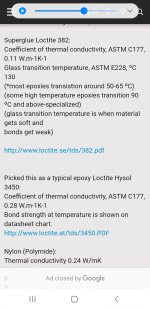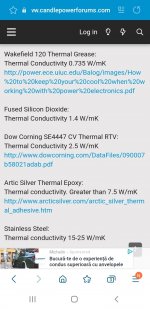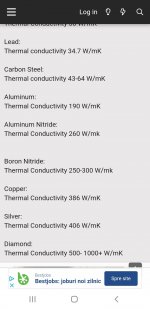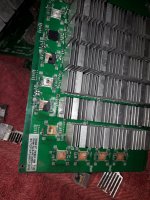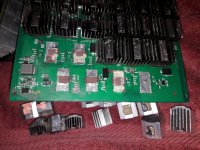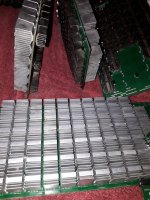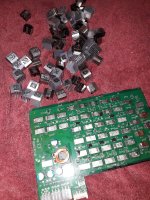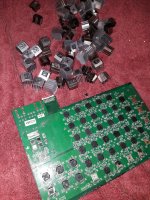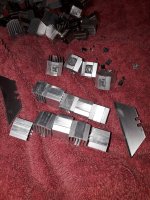I have used super glue to mount hot foil stamping zinc blocks.
It works to transmit heat to about 130 C.
Both sides must be flat, and the gap very small.
Clean well with acetone, and use that to slow down the glue setting if needed.
I did not mix it, so I cannot say if your idea will work.
It works to transmit heat to about 130 C.
Both sides must be flat, and the gap very small.
Clean well with acetone, and use that to slow down the glue setting if needed.
I did not mix it, so I cannot say if your idea will work.
First of all cooling paste has silicon oils in it which will not let any glue do its job.
Attachments
It should be easy to disassemble, what is your issue with the normal mechanical mounting style of clips / screws / rivets?
You can use the silicon used for car tappet covers or a high temperature grade, that also will work.
Epoxy or super glue would need hammer and chisel, or abrasion to open up, not good for the rest of the parts in the circuit.
You can use the silicon used for car tappet covers or a high temperature grade, that also will work.
Epoxy or super glue would need hammer and chisel, or abrasion to open up, not good for the rest of the parts in the circuit.
+1 on "oil and water do not mix", here oil (a slippery lubricant) and any adhesive.
Absolutely opposite functions/an oxymoron.
Absolutely opposite functions/an oxymoron.
The Thermal Adhesive I refered to is re-workable unlike most epoxy adhesive.
A firm twist will break the seal but tension will not.
A firm twist will break the seal but tension will not.
Yes and no...@jneuteon says its better to have a thicker paste than a thiner one with regular not so polished heatsinks and he's an expert in it, so arctic silver is actually better due to its viscosity...which is unexpected.
Probably a different scenario, but I used to own a car with a rear view mirror whose metal mounting block was glued to the inside of the windscreen. One day it came unstuck and I repaired it with super glue. On the next hot day it fell off, and it did this again until I tried using epoxy.Don’t use superglue. Use a good thermal epoxy like the one Jon Snell linked to.
I bought recently some scraped mining boards for heatsinks, but the joy was half lived...only the heatsinks from the opposite side of the chips are easy to use, the rest of them needs serious polishing due to hardened epoxy that took the chip with it.
Attachments
True with aluminium heatsinks too, superglue not reliable enough and worse thermal coeficient than epoxy resin.It helps roughly polishing both heatsink and chips though to increase the contact area.Hardly doable with glass...One day it came unstuck and I repaired it with super glue. On the next hot day it fell off, and it did this again until I tried using epoxy.
Hello,
Superglue does work well, but need to meet certain conditions before it holds well. FWIW
1. Both surfaces should be quite flat.
2. Both surfaces need to be spotlessly clean. No finger oil residue or anything else. Clean with alcohol as the last step.
Regards,
Greg
Superglue does work well, but need to meet certain conditions before it holds well. FWIW
1. Both surfaces should be quite flat.
2. Both surfaces need to be spotlessly clean. No finger oil residue or anything else. Clean with alcohol as the last step.
Regards,
Greg
I stopped using any brand of liquid Super Glue years ago.Probably a different scenario, but I used to own a car with a rear view mirror whose metal mounting block was glued to the inside of the windscreen. One day it came unstuck and I repaired it with super glue. On the next hot day it fell off, and it did this again until I tried using epoxy.
They leave a nasty residue/blemish on nearby areas.
Much better to use an epoxy like those 'twin tube' types.
And for certain situations where extreme strength is needed, J-B Weld is great stuff, the slow curing results in an incredibly strong joint.
- Home
- Amplifiers
- Class D
- Can you mix cooling paste and superglue ?
